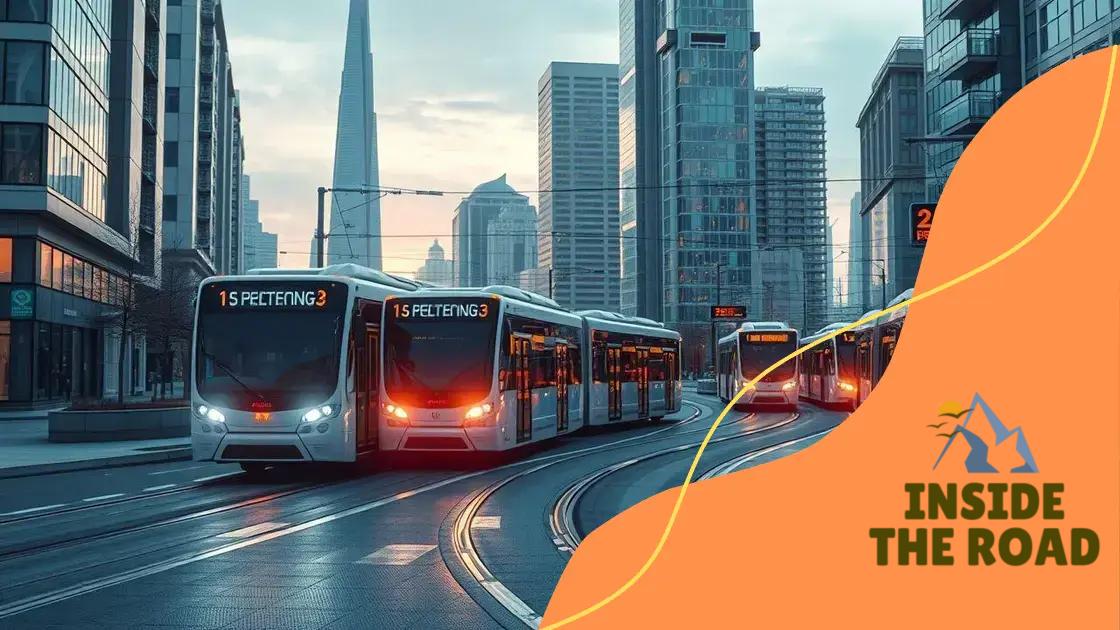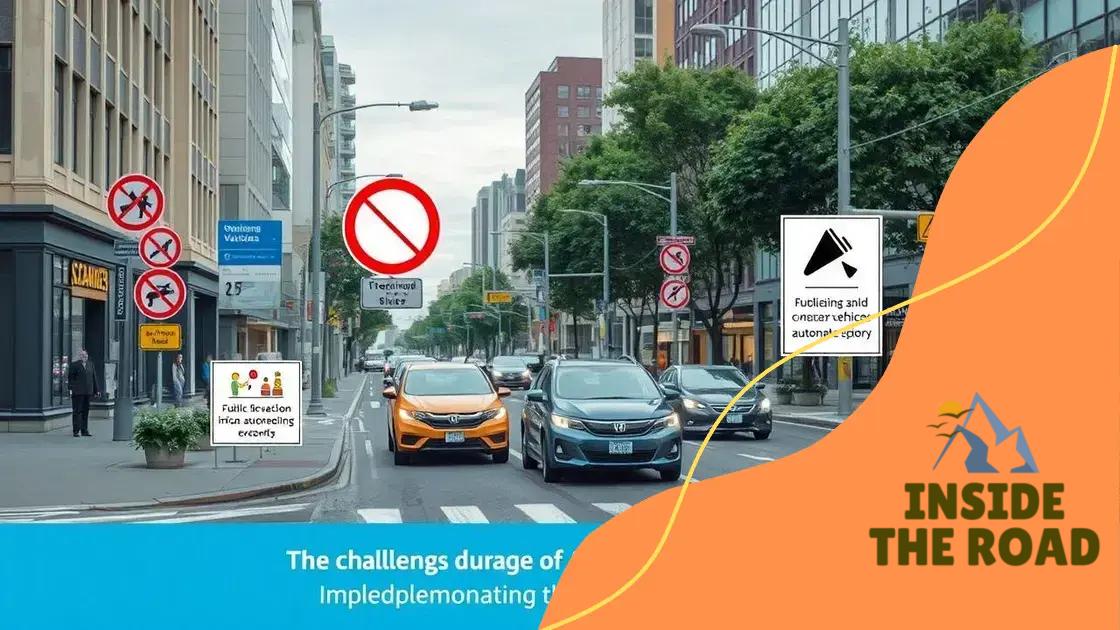The future of autonomous vehicles in public transport systems

The future of autonomous vehicles in public transport systems promises increased safety, cost efficiency, and environmental sustainability, while facing challenges such as regulatory compliance and public acceptance.
The future of autonomous vehicles in public transport systems promises to reshape how we navigate our cities. Have you ever imagined a world where public transport is fully automated? In this article, we’ll explore the transformative potential of these technologies.
Understanding autonomous vehicles
Understanding autonomous vehicles is the first step in grasping their transformative potential in public transport systems. These vehicles use a mix of sensors, cameras, and artificial intelligence to navigate without human input.
One of the most exciting aspects is their ability to improve safety. Traditional driving can be risky, but autonomous systems aim to reduce accidents caused by human error. With machine learning, these vehicles learn from various scenarios, enhancing their decision-making capabilities over time.
How do autonomous vehicles work?
At their core, autonomous vehicles rely on complex systems to interpret data from their environment. They use radar and lidar for distance measurement and cameras for visual recognition. By integrating this information, they create a detailed map of their surroundings.
- Real-time data processing
- Advanced sensors and cameras
- Machine learning for decision-making
- Communication with other vehicles
Moreover, autonomous vehicles communicate with each other, creating a network that can optimize traffic flow. This technology can lead to reduced congestion and more efficient routes.
Types of autonomous vehicles
Autonomous vehicles can be categorized into several levels. They range from basic driver assistance features to fully autonomous systems that require no human intervention. Understanding these levels helps us comprehend their deployment in public transport.
- Level 1: Driver Assistance
- Level 2: Partial Automation
- Level 3: Conditional Automation
- Level 4: High Automation
- Level 5: Full Automation
As technology evolves, higher levels will become more feasible for public transport, making services more accessible and efficient.
In essence, understanding autonomous vehicles is crucial as they represent the future of urban mobility. Their integration into public transport systems promises cost savings and improved user experience.
Benefits of autonomous public transport
The benefits of autonomous public transport are vast and transformative. These vehicles can enhance urban mobility, making public transport more efficient and accessible for everyone.
One major advantage is increased safety. Autonomous systems are designed to minimize human error, which accounts for the majority of road accidents. With advanced sensors and algorithms, these vehicles can react faster and make safer decisions than human drivers.
Cost Efficiency
Implementing autonomous public transport can also lead to significant cost savings. Operational costs can decrease due to reduced labor expenses and improved fuel efficiency. Moreover, maintenance costs may lower as these systems continuously monitor their performance and health.
- Reduced need for human drivers
- Lower fuel consumption through optimized routes
- Real-time diagnostics to prevent breakdowns
- Economies of scale in fleet management
Another key benefit is enhanced accessibility. Autonomous vehicles can be designed to serve areas with less coverage by traditional public transport, ensuring that all community members have reliable access to transportation. This flexibility can encourage more people to use public transit, leading to reduced traffic congestion.
Environmental Impact
Furthermore, autonomous public transport contributes positively to environmental goals. Many of these vehicles operate on electric or hybrid engines, which help lower carbon emissions. By improving public transport efficiency, we can decrease the number of individual cars on the road, resulting in cleaner air and less pollution.
In short, the benefits of autonomous public transport extend beyond mere convenience. They promise a safer, more cost-effective, and environmentally friendly solution to the challenges of urban mobility.
Challenges of implementation

The challenges of implementation for autonomous vehicles in public transport systems are significant and multifaceted. While the technology holds great promise, various barriers can hinder its success.
One of the primary challenges is regulatory compliance. Governments and local authorities must create new laws and guidelines to manage autonomous vehicles safely. This process can take time, leading to delays in deployment.
Public Acceptance
Another critical concern is public acceptance. People may feel uneasy about riding in vehicles without human drivers. Educating the public on safety and reliability is crucial to gaining their trust.
- Community outreach programs
- Transparency about safety measures
- Demonstrations of vehicle technology
- Addressing fears of job loss
Furthermore, integrating autonomous vehicles into existing infrastructure presents technical challenges. Many cities may not be equipped with the necessary technology for these vehicles to operate efficiently. Upgrading roads and connected traffic systems requires substantial investment and planning.
Cybersecurity Risks
Cybersecurity is another area of concern. With the reliance on software and connectivity, these vehicles are susceptible to hacking and cyber attacks. Ensuring robust security measures to protect user data and vehicle functionality is essential.
Overall, while the challenges of implementation are daunting, addressing them head-on with comprehensive strategies can pave the way for successful integration of autonomous vehicles into public transport systems.
Case studies around the world
Case studies around the world illustrate the practical application and success of autonomous vehicles in public transport systems. Various cities are leading the way in testing and implementing this innovative technology.
For instance, in Singapore, autonomous shuttles are already in operation, providing last-mile connectivity for commuters. These shuttles help reduce traffic congestion and offer a convenient transport option for residents. The system is continuously monitored and optimized to ensure safety and efficiency.
Success in Europe
In Europe, cities like Amsterdam and Paris are experimenting with autonomous buses. In Amsterdam, an autonomous bus service operates in designated areas, allowing passengers to experience the high-tech transport solution. With safety measures in place, these buses navigate city streets smoothly.
- Passenger feedback is collected for continuous improvement.
- Infrastructure is modified to support autonomous technology.
- Public campaigns educate residents about the benefits.
Meanwhile, Paris is trialing autonomous vehicles to enhance public transport options for busy urban areas. This approach aims to complement existing services and provide more travel choices for users.
Innovations in North America
In North America, places like Los Angeles are also making strides. The city tests autonomous shuttles to connect different neighborhoods, addressing the mobility gap in underserved areas. By analyzing data from these pilot programs, officials can better understand how autonomous vehicles can overcome specific transportation challenges.
Furthermore, cities are collaborating with tech companies to develop customized solutions suited for local needs. These partnerships are essential for advancing the technology and increasing public confidence in its safety and reliability.
Overall, these case studies showcase a promising future for autonomous vehicles in public transport, demonstrating their potential to improve urban mobility.
The role of technology in integration
The role of technology in the integration of autonomous vehicles into public transport systems is crucial. As cities evolve, the need for advanced technology grows to support seamless transportation.
One of the key technologies driving this integration is artificial intelligence (AI). AI enables autonomous vehicles to learn from their environment, improving their decision-making capabilities. With AI, these vehicles can analyze traffic patterns, recognize obstacles, and adapt to various driving conditions, ensuring safety and efficiency.
Connected Infrastructure
Additionally, the development of connected infrastructure is essential. Smart traffic lights and connected road systems help autonomous vehicles communicate with city infrastructure, enhancing their operation. This interaction allows vehicles to receive real-time updates about traffic conditions and adjust their routes accordingly.
- Improved vehicle-to-infrastructure communication
- Real-time traffic updates
- Adaptive traffic management systems
- Enhanced safety protocols
Another important aspect is the use of sensor technology. Autonomous vehicles are equipped with multiple sensors, including lidar, radar, and cameras, which help them perceive their surroundings. These sensors gather data that is crucial for navigation and obstacle avoidance.
Data Analytics
Furthermore, data analytics plays a vital role in optimizing public transport systems. By collecting and analyzing travel data, cities can make informed decisions about service improvements. Understanding passenger behavior helps transit agencies enhance routes and schedules, making public transport more appealing.
Ultimately, the role of technology in the integration of autonomous vehicles is to create a cohesive transportation network. By leveraging advancements in AI, connected infrastructure, and data analytics, cities can offer residents a reliable and efficient public transport experience.
FAQ – Frequently Asked Questions about Autonomous Vehicles in Public Transport
What are the primary benefits of autonomous vehicles in public transport?
The primary benefits include increased safety, cost efficiency, and reduced environmental impact.
What challenges do cities face in implementing autonomous vehicles?
Cities face challenges such as regulatory hurdles, public acceptance, and the need for new infrastructure.
How does technology enable the integration of autonomous vehicles?
Technology like AI, connected infrastructure, and sensor technology allows vehicles to operate safely and efficiently.
Can you provide examples of cities successfully using autonomous vehicles?
Yes, cities like Singapore and Amsterdam are leading in the adoption and experimentation of autonomous public transport.






